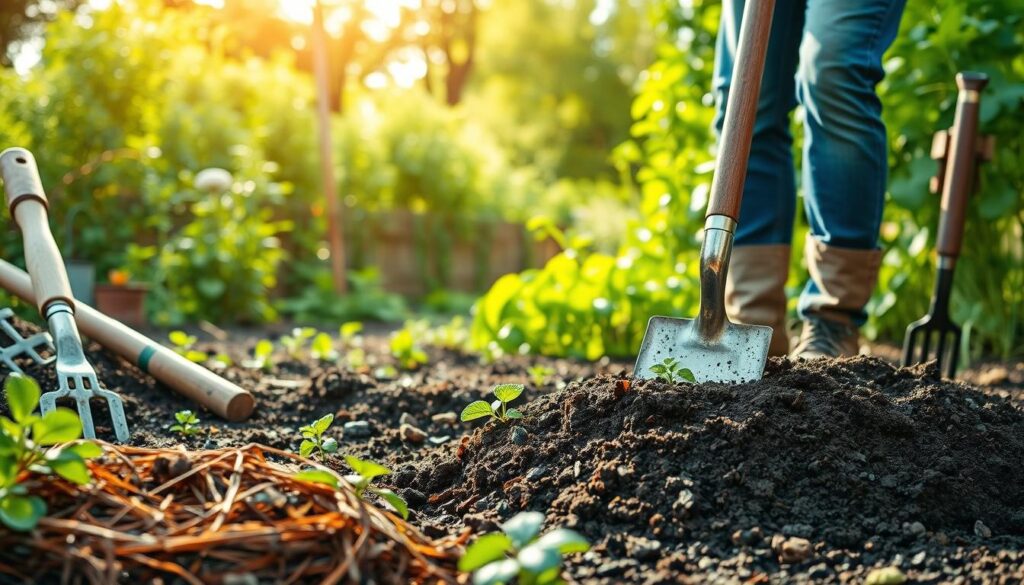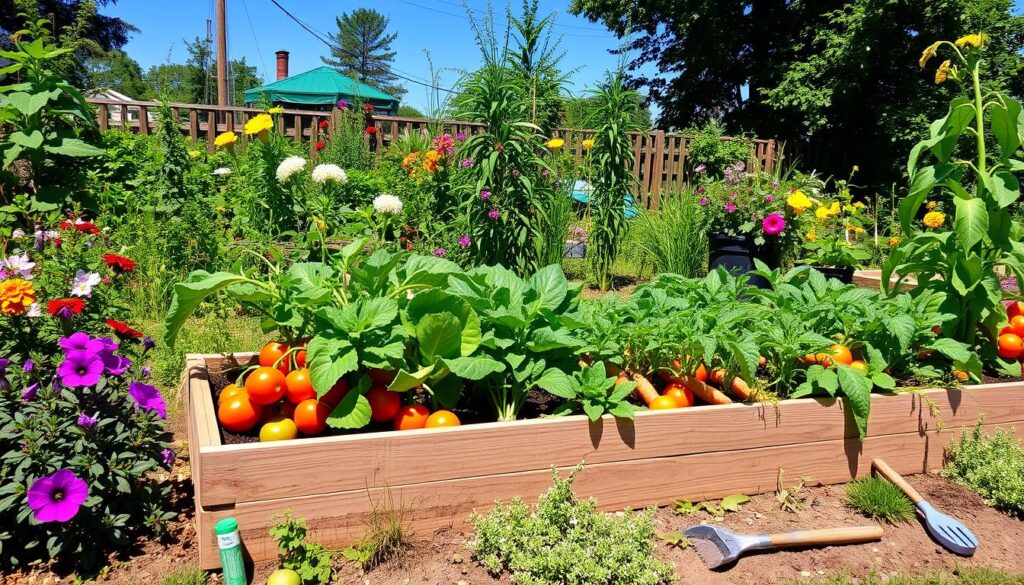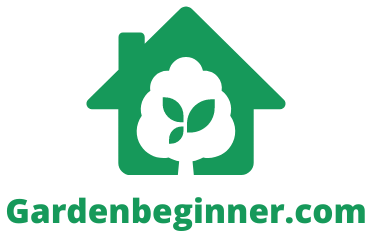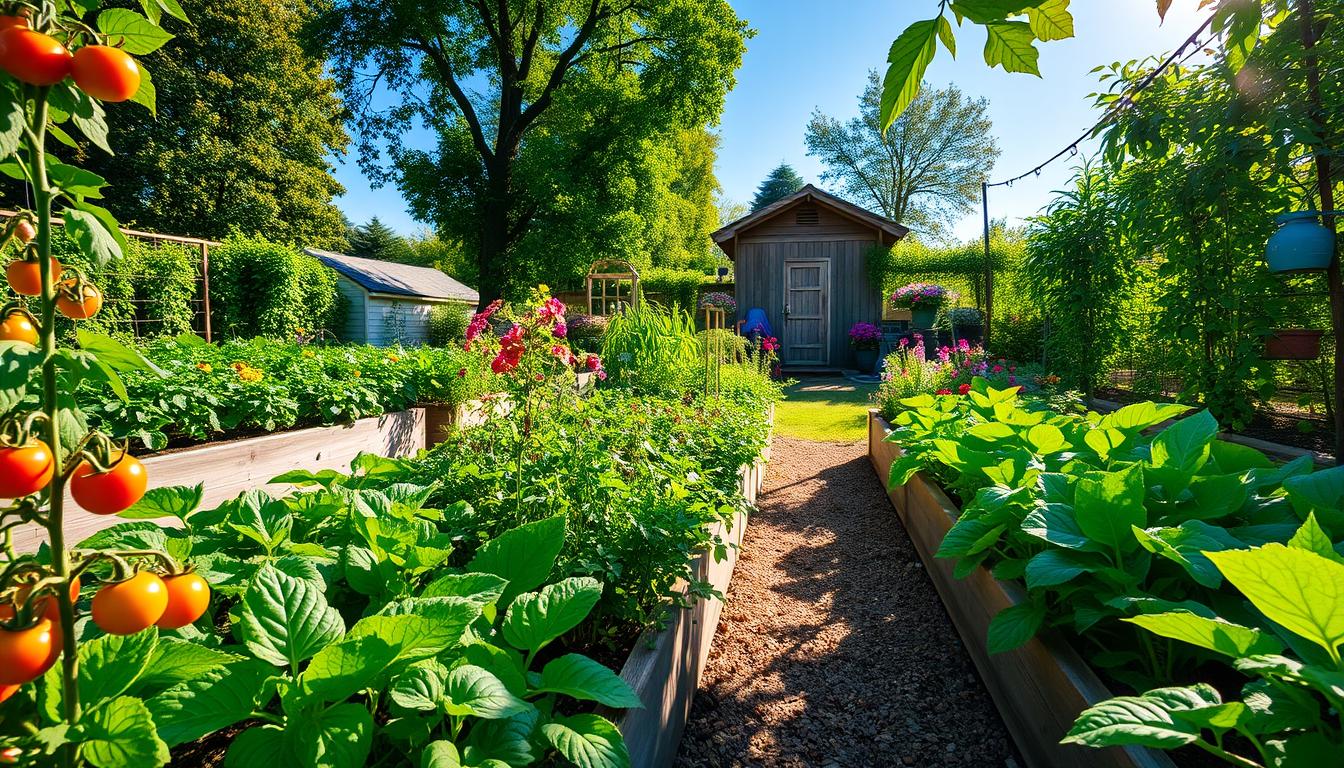Start an exciting journey into vegetable gardening with this guide for beginners. You can grow your own food, no matter the size of your space. This guide will help you plan, plant, care for, and harvest your crops.
Key Takeaways
- Discover the numerous health and sustainability benefits of growing your own vegetables at home.
- Learn how to plan and design your vegetable garden, including choosing the right location and layout.
- Understand the importance of soil preparation and maintenance for a successful harvest.
- Explore a wide range of vegetable varieties and select the best options for your climate and preferences.
- Master the techniques for proper planting, spacing, and caring for your vegetable plants.
- Implement effective watering, irrigation, and nutrient management strategies.
- Adopt organic and sustainable methods to control pests and diseases in your vegetable garden.
The Importance of Growing Your Own Vegetables
Growing your own vegetables at home has many benefits. It can improve your health and reduce your environmental impact. Home vegetable gardening is great for anyone wanting a sustainable and healthy lifestyle.
Health Benefits of Homegrown Produce
Homegrown produce is fresher and tastes better than store-bought. It also has more nutrients. Homegrown vegetables don’t have harmful chemicals found in many commercial crops. This means you get more vitamins, minerals, and antioxidants.
Gardening itself can also make you healthier. It encourages physical activity and improves your mental health. This contributes to your overall well-being.
Environmental Benefits of Vegetable Gardening
Home vegetable gardening is good for the planet too. It helps reduce your carbon footprint by cutting down on transportation and processing. Home gardens also save water, reduce waste, and support local wildlife.
These benefits make home gardens key to a greener lifestyle. They are essential for a more sustainable food system.
| Benefits of Home Vegetable Gardening | Health Benefits of Homegrown Produce | Environmental Benefits of Vegetable Gardening |
|---|---|---|
|
|
|
By growing your own vegetables at home, you gain many benefits. These benefits include better health for your family and a positive impact on the environment. The advantages of home vegetable gardening are truly impressive.
“Growing your own food is a revolutionary act.”
– Ron Finley, urban gardener and food justice activist
Planning Your Vegetable Garden
Starting a vegetable garden needs careful planning. First, pick the best spot for your garden. Think about sunlight, soil, and how easy it is to get to. After finding the right place, design a layout that uses your space well.
Choosing the Right Location
Look for a spot that gets 6-8 hours of sunlight a day. Your veggies need well-draining, rich soil. Also, pick a place close to your kitchen for easy access.
Tip: Avoid areas near trees or shrubs, as their roots can compete with your vegetables for resources.
Designing the Garden Layout
After picking the perfect spot, plan your garden’s layout. A good layout saves space and makes caring for your garden easier. Use raised beds or rows with paths in between.
- Group plants with similar growing requirements together for efficient watering and care.
- Incorporate companion planting techniques to naturally deter pests and promote plant health.
- Leave enough space between plants to allow for proper growth and air circulation.
By planning your garden well, you’ll have a great harvest. Start small and grow your garden as you get more experience.
“The key to a successful vegetable garden is in the planning. Take the time to choose the right location and design an efficient layout – it will pay off in the long run.”
Preparing the Soil for Planting
Healthy soil is key for a great vegetable garden. It needs the right nutrients, drainage, and structure for plants to grow well. I’ll show you how to test, amend, and create the best soil for your plants.
Testing Your Soil
Start by testing your soil. A test will show the pH level, nutrient content, and any issues. This info helps you know what to add to your soil. You can buy a test kit or send a sample to a lab for detailed results.
Amending the Soil
After testing, add the needed materials to your soil. Use compost, aged manure, peat moss, and lime or sulfur to adjust pH. Mix these into the soil 6-8 inches deep for even distribution.
| Soil Amendment | Purpose |
|---|---|
| Compost | Adds organic matter, improves soil structure, and increases nutrient content |
| Aged Manure | Provides nutrients and improves soil texture |
| Peat Moss | Increases water-holding capacity and improves soil structure |
| Lime or Sulfur | Adjusts soil pH to the optimal range for vegetable plants |
The right amount and type of amendments depend on your soil test. Always follow the recommended amounts to avoid over- or under-amending.

By preparing your soil well, you set your garden up for success. With the right conditions, your plants will get the nutrients and care they need to thrive.
Selecting the Best Vegetable Varieties
Choosing the right vegetable varieties is key to a thriving home garden. Consider your climate, growing season, and personal taste. This ensures a harvest that meets your needs and desires.
Factors to Consider for a Successful Harvest
Choosing the right vegetable varieties is crucial for a successful vegetable harvest. Here are important factors to think about:
- Climate Compatibility: Pick vegetable varieties that fit your local climate. This ensures they grow well and give you a good harvest.
- Maturity Timing: Know the days to maturity for each variety. This helps plan your harvest and enjoy a steady supply of fresh vegetables.
- Flavor Preferences: Think about your taste preferences when picking varieties. Choose ones that match your cooking style for a rewarding harvest.
- Pest and Disease Resistance: Choose varieties that resist pests and diseases. This reduces the need for pesticides and keeps your garden healthy.
| Vegetable Variety | Climate Compatibility | Maturity Timing | Flavor Profile | Pest/Disease Resistance |
|---|---|---|---|---|
| Cherry Tomato | Warm, Sunny | 60-70 days | Sweet, Juicy | High |
| Zucchini | Warm, Moist | 45-60 days | Mild, Versatile | Moderate |
| Carrots | Cool, Sandy | 70-90 days | Sweet, Earthy | High |
By considering these factors, gardeners can pick the best varieties for their garden. This ensures a successful vegetable harvest that meets their needs.
“The joy of growing your own food is unparalleled. By selecting the right vegetable varieties, you can create a bountiful and sustainable vegetable selection for home garden.”
Planting and Spacing Vegetables
Proper planting and spacing are key for healthy vegetable plants. As a gardening fan, I’ll share tips on the best planting methods and spacing. This will help your garden grow well and produce lots of food.
Vegetable Planting Techniques
When planting vegetables, being precise is important. First, make sure the soil is good for plants. Then, follow these steps for planting success:
- Dig shallow holes or furrows at the right depth for each vegetable.
- Put seeds or seedlings in the holes, spacing them as needed.
- Cover the seeds or seedlings with soil, but don’t pack it too hard.
- Water the plants well to help them settle in.
Plant Spacing in the Vegetable Garden
Right spacing is key for your vegetables to grow well. Each vegetable needs different space. Here are some general spacing tips:
- Leafy greens: 6-12 inches between plants
- Root vegetables: 2-4 inches between plants
- Tomatoes, peppers, and other big vegetables: 18-24 inches between plants
Choosing the right vegetable plant placement is important. It lets each plant get enough room to grow. This prevents them from competing for space and resources.
| Vegetable Variety | Recommended Spacing |
|---|---|
| Lettuce | 6-12 inches between plants |
| Carrots | 2-4 inches between plants |
| Tomatoes | 18-24 inches between plants |
| Bell Peppers | 18-24 inches between plants |
By using these vegetable planting techniques and spacing tips, you’ll have a great vegetable garden. It will be full of life and produce lots of food.
The Ultimate Guide to Growing Vegetables at Home for Beginners
Are you ready to start growing your own veggies at home? You’re in the right spot if you’re new to gardening. This guide will show you how to plan, plant, and care for your garden.
You can grow veggies anywhere, from a small patio to a backyard or even a windowsill. Follow these beginner vegetable gardening guide tips and advice for new vegetable gardeners. You’ll soon enjoy the many benefits of growing vegetables at home.
Planning Your Vegetable Garden Layout
Start by planning your garden layout. Think about the space, sunlight, and soil. Make a plan that uses the space well and gives your plants what they need.
- Find a spot that gets at least 6 hours of sunlight a day.
- Measure the area and draw a layout that fits the space.
- Choose a mix of fast-growing and slow-growing veggies.
Preparing the Soil for Planting
Good soil is key for a great garden. Improve your soil before planting to give your veggies the best start.
- Check your soil pH and adjust it for the best growing conditions.
- Add organic matter like compost or manure to make the soil better.
- Loosen the soil to 8-12 inches deep to help roots grow.
By following these tips for growing vegetables at home, you’ll get a lot of fresh produce. Remember, gardening takes patience, dedication, and a love for learning. Happy gardening!

Watering and Irrigation Techniques
Keeping your vegetable garden hydrated is key to its health and growth. Whether you’re new to gardening or have years of experience, knowing the best ways to water is crucial. We’ll look at different methods to keep your soil moist and ensure your veggies get the water they need.
Keeping Your Plants Hydrated and Healthy
Watering your garden right is all about finding the right balance. This balance depends on your garden’s climate, soil, and the types of plants you have. Here are some irrigation techniques to help you keep your soil moist:
- Drip Irrigation: This method sends water straight to the roots, cutting down on evaporation and focusing on hydration.
- Soaker Hoses: These hoses slowly release water, making them perfect for gentle, even watering.
- Sprinklers: Sprinklers can cover a lot of ground, but be careful not to waste water or soak your plants’ leaves.
- Hand Watering: While it takes more time, watering by hand lets you check on each plant’s needs.
Choose the method that works best for you, but always aim for consistent moisture without too much water. Check your soil often and adjust your watering schedule as needed. This will help you find the perfect balance for your vegetable garden watering needs.
| Irrigation Method | Efficiency | Water Conservation | Ease of Use |
|---|---|---|---|
| Drip Irrigation | High | Excellent | Moderate |
| Soaker Hoses | Moderate | Good | Easy |
| Sprinklers | Moderate | Fair | Easy |
| Hand Watering | Low | Fair | Time-consuming |
By trying out these irrigation methods for home gardens and adjusting them to fit your garden’s needs, you’ll be on the path to maintaining plant hydration. This will help your vegetable garden stay healthy and productive for a long time.
Fertilizing and Nutrient Management
Keeping the right balance of nutrients is key for your vegetable plants to grow well. As a gardener, knowing how to fertilize and manage nutrients is crucial. This helps your home vegetable garden thrive.
Good fertilization gives your plants the nutrients they need. This includes macronutrients like nitrogen, phosphorus, and potassium. It also includes micronutrients like calcium, magnesium, and iron. Nutrient deficiencies can cause stunted growth, discoloration, and lower yields. A balanced fertilization plan helps your soil and plants stay healthy.
Organic Fertilizers for Home Gardens
Using organic fertilizers is a green and effective way to feed your garden. These natural products come from plants or animals. They release nutrients slowly, just like nature does. Here are some common organic fertilizers:
- Compost: It’s made from decomposed organic matter and has all the nutrients your plants need.
- Manure: It’s animal waste that makes the soil better and adds nutrients.
- Bone meal: It’s full of phosphorus and calcium, great for roots and flowers.
- Blood meal: It’s packed with nitrogen, helping plants grow leaves fast.
- Rock phosphate: It’s a phosphorus source that helps with root growth and fruiting.
Adding organic fertilizers helps nourish your plants. It also keeps your garden healthy and sustainable for the long term.
“Healthy soil is the foundation for a thriving vegetable garden. Proper fertilization and nutrient management are essential for unlocking the full potential of your homegrown produce.”
Pest and Disease Control
Keeping your vegetable garden healthy means watching out for pests and diseases. Organic and sustainable methods help protect your plants. They also keep your garden in balance with nature.
Organic Pest Control Methods
Organic pest control uses natural, safe ways to fight off garden pests. Here are some effective methods:
- Companion planting: Some plants, like marigolds or lavender, can keep pests away.
- Introducing beneficial insects: Ladybugs, lacewings, and praying mantises eat pests like aphids and mites.
- Applying neem oil or insecticidal soap: These plant-based products kill pests without harming your veggies.
Natural Disease Prevention Strategies
Stopping plant diseases is crucial for a healthy harvest. Try these eco-friendly gardening tips:
- Rotate crops every year to break disease cycles.
- Keep plants well-spaced to prevent fungal diseases.
- Choose disease-resistant plants when you can.
- Use natural fungicides like baking soda or compost tea to fight fungal diseases.
Using organic pest control and natural disease prevention keeps your garden healthy. It also helps the environment.
| Organic Pest Control Method | Targeted Pests | Benefits |
|---|---|---|
| Companion Planting | Aphids, Cabbage Worms, Spider Mites | Natural pest deterrence, Enhances biodiversity |
| Beneficial Insects | Aphids, Mites, Caterpillars | Effective natural pest control, Supports ecosystem balance |
| Neem Oil or Insecticidal Soap | Aphids, Whiteflies, Thrips | Plant-based, non-toxic solutions, Protects vegetables |
“Sustainable gardening is not just about the plants – it’s about creating a thriving ecosystem that works in harmony.”
Harvesting and Storing Your Vegetables
The final step in growing your own vegetables is the rewarding process of harvesting and storing your fresh produce. As an experienced gardener, I’ll share practical tips. These tips will help you determine the optimal harvest time and how to store your homegrown vegetables. This way, you can keep them fresh and full of nutrients.
Knowing when to harvest your vegetables is key for their best flavor and texture. Leafy greens like spinach and kale are best picked when young and tender. Root vegetables like carrots and beets should be harvested when they reach the right size. By watching your crops grow, you can enjoy a bountiful and delicious harvest.
After harvesting, it’s important to handle your vegetables with care. Gently wash them, remove any damaged parts, and store them properly. Using the right storage conditions, like refrigeration, can help keep your vegetables fresh for longer. You can also try preserving methods like canning, freezing, or dehydrating. This way, you can enjoy your garden-fresh produce all year round.



Leave a Reply